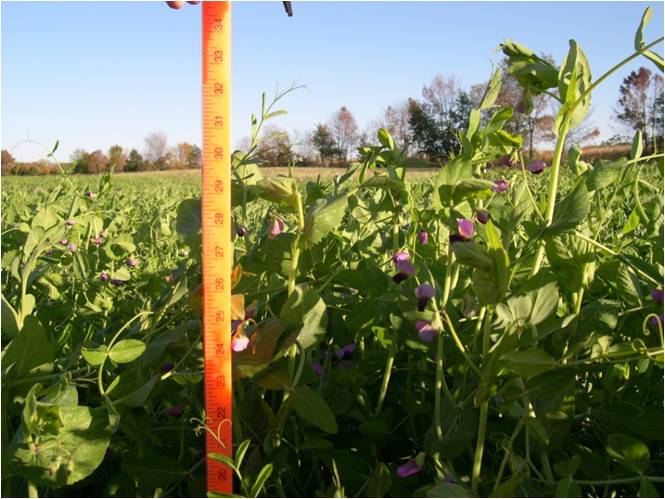In this cover crop post I again quote Paul Conway from Kansas, who is giving his input on cover crops in the Great Plains. In this article, Paul shares his experience with Austrian winter peas, field peas, chickling vetch, and hairy vetch.
Dave,
Austrian Winter Peas: I have limited and disappointing experience with Austrian Winter Peas. They always winter kill and they must be planted at an inconvenient time. It seems that the areas where they do well do not follow a simple geographical line. Austrian Winter Peas do very well about 60 miles south of me in central and southern Kansas. Ironically, they seem to do fine in the Nebraska panhandle, which is much colder than we are. I think consistent snow cover makes the difference.
Field Peas: also know as Canadian field peas or forage peas. I’ve grown these in early fall with oats and forage radish. I don’t know how much nitrogen they fix but they do winterkill by early winter – mine haven’t died yet – probably consistent lows in the middle teens will do it.
I also plant them in early spring the same time as oats, killing them for June planted cash crops. Mowing after flowering will effectively kill peas. Where peas shine is in mixes and in cool climates.
The pea/oat or pea/triticale is excellent for haylage or silage. These mixes have the same benefits for livestock farmers as the soybean/summer grass mixes.
In much of the Midwest and east, double cropping is possible, oat/peas followed by soybean/milo or sorghum-sudan. Further north, the oat/pea mixes would mature too late. In that regard, I think that field peas could be managed as a summer annual (like soybeans) in the Great Lakes states, upstate New York, Pennsylvania, and New England.
Peas can handle routine summer temperatures in the low-mid 80s. Peas can be grazed. Peas aren’t shade tolerant so they don’t do well when sown into row crops. Frankly outside the mixes I think the clovers may be more versatile.
Chickling Vetch: Also known as “AC Greenfix.” It will fix nitrogen faster both in the fall (it winterkills about the same time as the peas) and in the spring. AC Greenfix seed is more expensive and harder to plant due to it’s shape.
Hairy Vetch: As you know, hairy vetch is the strongest nitrogen fixer among the annuals. Hairy vetch easily fits into vegetable rotations. I have seen two foot vine growth and numerous fat nodules on vetch in early-mid April after a mildly wet fall and an early spring. It will be harder to fit into field crop rotations, especially corn-soybeans.
Here the optimum time to plant hairy vetch is September, but it can be planted as late as mid October. It needs minimal soil contact which isn’t a problem in a normal fall. A dry September/October, like I had this year, is a problem.
I know that you have some experience with flying in hairy vetch into maturing corn or soybeans. Another option is to plant it very late (mid-late November) and hope it doesn’t germinate until the soil warms up in late winter-early spring. I don’t think people realize how versatile hairy vetch can be. In the northern areas suited for field peas (see above) hairy vetch could be managed as a summer annual. [I have seen hairy vetch flower, drop seed which stays dormant during a hot dry summer – Dave’s EMPHASIS HERE – this is why I caution growers about Hairy Vetch.] When the weather cools down in late August the vetch seed sprouts. It is still warm then through September and early October with temperatures similiar to the Great Lakes states and New England in the summer. So why couldn’t vetch be planted in early summer in these areas?
Years ago I planted hairy vetch in April between wide rows of vegetables just to see what would happen. I remember lots of growth by July, despite a hot dry summer. The soil under the vetch was cool and moist. The vetch did not grow enough to fix much nitrogen by May but it may have fixed enough nitrogen for mid-summer planted crops.
In 2012 I will plant hairy vetch and other vetches (purple) in the spring and record how they do.
Finally, new cultivars of hairy vetch come out which may have promise. I will try a new variety called Purple Bounty, which is supposed to mature two weeks earlier but with less winter hardiness.


Pingback: bokashicomposting.com - Cover Crops in the Great Plains – a view from a long time cover crop user- Part 2
larry bonnell from michigan have been planting austrian winter peas and annual ryegrass with good results.snow cover is normally is on the ground all winter.i do not bale wheat straw.i use the straw chopper and chop it fine.have been using a cocktail mix for 12 years.good luck